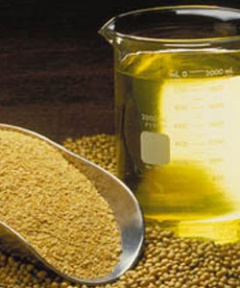Soybean oil
| Infobox on Soybean oil | |
|---|---|
| Example of Soybean oil |  |
| Facts | |
| Origin | - |
| Stowage factor (in m3/t) | - |
| Humidity / moisture | - |
| Ventilation | - |
| Risk factors | See text |
Soybean oil
Description
Soybean oil is a vegetable oil extracted from the seeds of the soybean (Glycine max). It is one of the most widely consumed cooking oils. As a drying oil, processed soybean oil is also used as a base for printing inks (soy ink) and oil paints.
To produce soybean oil, the soybeans are cracked, adjusted for moisture content, heated to between 60 and 88 ºC , rolled into flakes, and solvent-extracted with hexanes. The oil is then refined, blended for different applications, and sometimes hydrogenated. Soybean oils, both liquid and partially hydrogenated are sold as "vegetable oil," or are ingredients in a wide variety of processed foods. Most of the remaining residue (soybean meal) is used as animal feed.
Soybean oil is a drying oil, which means that it will slowly harden upon exposure to air, forming a flexible, transparent, and waterproof solid. Because of this property, it is used in some printing ink and oil paint formulations. Soy oil smells and tastes like a meat extract.
Application
Soybean oil is used as an edible oil and hardened as an edible fat. It is also used in the production of margarine, confectionery, linoleum, soaps and as an additive to linseed or tung oil.
Shipment / Storage
Under normal transport conditions, soybean oil is liquid and therefore need not be heated. However, if extremely low temperatures should arise during the voyage which are in the solidification range, the oil has to be heated to prevent losses in quality and to achieve pumpability.
| Loading temperature | 24°C. |
| Travel temperature (favorable temperature range) |
15°C (12-25°C) |
| Solidification temperature | -8 - -18°C. |
| Pumping temperature | 27°C. |
Ventilation must not be carried out under any circumstances, as it would supply fresh oxygen to the cargo, which would promote oxidation processes and premature rancidity.
For further details on deterioration, contamination, oxidation, transit and handling etc., we may refer to Bulk Oils and Fats and Fats and Oils











